SEO for Voice Search: 5 Ways to Get It Right

While you are in the constant process of optimizing your site for desktop (yes, Google updates, almost half the space of the SERP occupied with the results from the Google Knowledge Graph, etc.), you suddenly realize that you also have to optimize it for mobile search, considering Google's focus on mobile-first indexing.
And then, when you are at peace with all the things you will have to do and take into account, there it comes — voice search optimization. Pretty painful. But, you know, everything is difficult before it's easy. All we need is some understanding of what is going on and the plan for what to do.

1. OK, Google.
All major technology providers, not just Google, are investing in virtual assistants — and by extension, voice search. Google has Google Assistant, Apple has Siri, Amazon has Alexa, Microsoft has Cortana, Samsung has their new Bixby, and Yandex launched Alice — the first AI voice assistant for the Russian market. Plus, Amazon Echo and Google Home that are always happy to play you some music or audiobook, create to-do lists, set alarms, and control smart devices in your home. Even fridges are smart and sociable now.
And though virtual assistants have been there for a couple of years already, the era of this phenomenon is still at its dawn, and we should be ready for new progressive developments on this part really soon. Whether you are skeptical about it or not, according to MindMeld, in 2015 voice search jumped from zero to 50 billion searches a month. SEO company HigherVisibility surveyed 2,000 mobile phone users and found that 27% of respondents use voice search assistants daily, while another 27% use them at least once a week. This is not a thing to pass over.
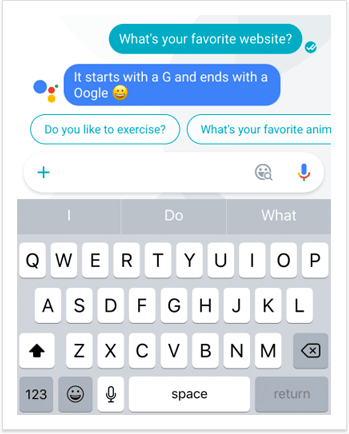
Voice assistants rely on natural language processing. It means that over time they learn the patterns unique to the person who speaks to them, their preferences in restaurants, transport, shops, and other kinds of their behavior. On the basis of this knowledge, virtual assistants will provide tailored and relevant search results that vary depending on the user.
The rise of voice assistants has dramatic implications for brands that rely on search to drive traffic to their site. Voice search has fundamental differences from typed search. We will talk about it below in more detail (and what to do about it in terms of your site). Plus, voice commerce represents a whole new challenge for trading business that is still adjusting to the world where most of traffic is mobile.
When it comes to SEO, we should understand that all the things that virtual assistants can do and that can have any SEO value (like choosing restaurants, buying tickets, etc.) will still be powered by search. Though, it will obviously be a new market, as we compete to become those services that are preferred by voice assistants. And it is clear that the competition will be much tougher as there will be just one spot to compete for.
If you wonder what you have to do in the face of this evolution and how to make your content speak to users, check out the techniques that can make you more visible to this kind of searchers.
2. But first, mobile.
Now, the convenience that goes with voice search is usually associated with mobile, as most voice queries come from smartphones.
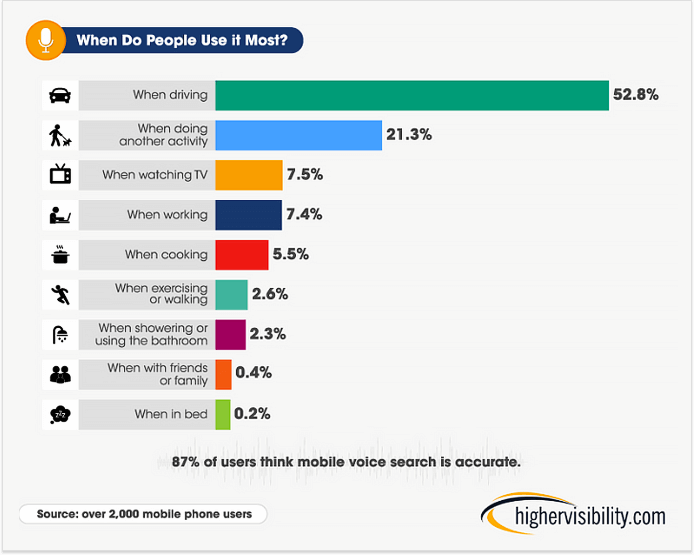
Following this rise of mobile use, Google is now switching to mobile-first indexing that will most probably be complete in mid-2018. When the shift is done, mobile indexing will be coming before desktop.
In such a situation, voice search is now experiencing exponential growth. It is not hard to see why. Voice searches are fast (we can speak ~150 words per minute opposed to typing 40 words per minute), convenient (hands-free), and reliable (voice recognition gets increasingly accurate). Just look at those numbers:
- "Google voice search queries in 2016 are up 35x over 2008", according to Google Trends via Search Engine Watch.
- More than half of queries will be voice search by 2020, according to Google.
Of course, it is not disastrous. Voice search won't kill screens, likewise mobile did not kill desktop (though there were some concerns after so-called Mobilegeddon). However, smartphones are so sewn into our lives that most of us cannot imagine our day without checking the phone about 100 times and leaving our homes without it (otherwise, we can face some unhealthy anxiety). These tendencies form our behavior on the Web and our attitude to search.
When it comes to quick queries that should take a minute or a couple of seconds, most probably, people will go for mobile. This phenomenon even has a name — micro-moments. They're the moments when we turn to a device — often a smartphone — to take action on whatever we need or want right now: to consult on a possible purchase, get inspiration, choose a restaurant, or look up plane tickets. Google divides micro-moments into 4 types:
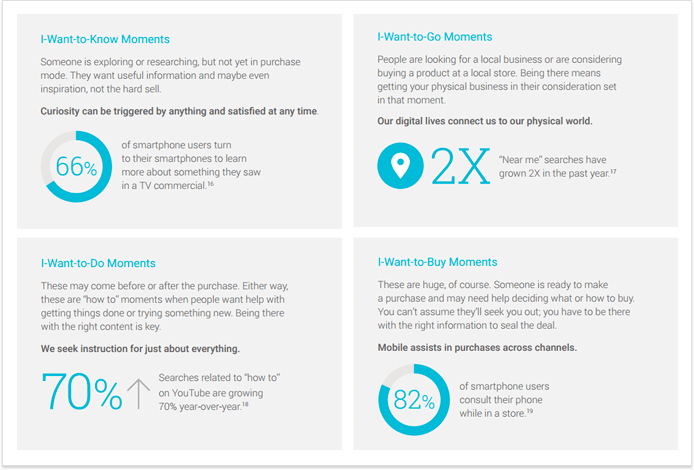
Thus, these micro-moments are the battleground for brands. 65% of smartphone users agree that when conducting a search on their smartphones, they look for the most relevant information regardless of the company providing the information. Urgency is a key factor here — you have to be there when this very moment pops up, and you have to be quick and efficient to make a potential consumer yours. Voice search or not, in other words, you have to be mobile-friendly.
How-to
1. Use Google Search Console.
Add and verify the mobile version of your site in Google Search Console.
2. Test your pages for mobile-friendliness.
Before you go for a check, remember that mobile friendliness is assessed on a page basis, which means that you have to check each landing page for this factor, one at a time. You can do that speedily with WebSite Auditor — Google's test just for this particular factor is incorporated into the tool.
Create a project for your site or open an existing one, go to Content Analysis > Page Audit, add a page you want to analyze, and enter your target keywords. When the check is done, switch to Technical factors and scroll to the Page usability (Mobile) section to see if there are any problems detected.
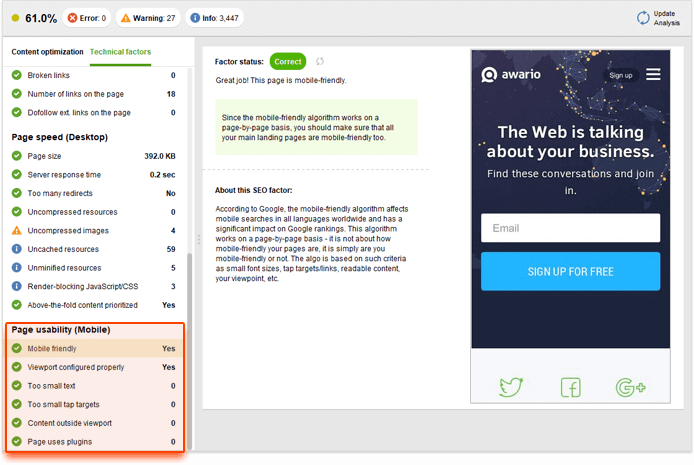
3. Do an in-depth mobile audit.
In your WebSite Auditor project go to Preferences > Crawler Settings, make sure the Follow robots.txt instructions box is checked; in the drop-down menu next to it choose Googlebot-Mobile. Right below, check the Crawl as a specific user agent box. In the drop-down menu to the right, pick the second user agent on the list:
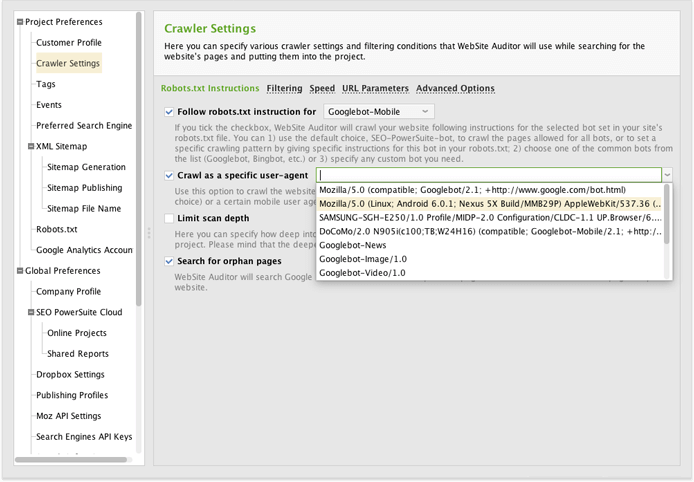
That's the user agent Google uses when crawling mobile versions of pages. Press OK and click the Rebuild Project button. In a moment, the tool will conduct a full audit of your mobile website. If you have a larger website, don't forget to mind the crawl budget.
4. Keep all your resources crawlable.
Make sure your mobile site doesn't block CSS, JavaScript, images, videos, etc.
5. Avoid Flash.
Flash isn't supported by most mobile (and many desktop) browsers. To make sure Google (and visitors) can access all content on your site, it's best to avoid the use of Flash on your mobile pages.
6. Optimize load time.
40 percent of mobile searchers will wait no more than three seconds before abandoning a site (judge by yourself). Compressing your images is the simplest way to improve mobile UX and page speed. You can get a ready link for downloading your compressed images in WebSite Auditor. In your project go to Content Analysis and select a page you need to analyze. Proceed to Page Audit > Technical factors, scroll to the Page speed (Desktop) , click on Uncompressed images, and get a link in the How to fix section.
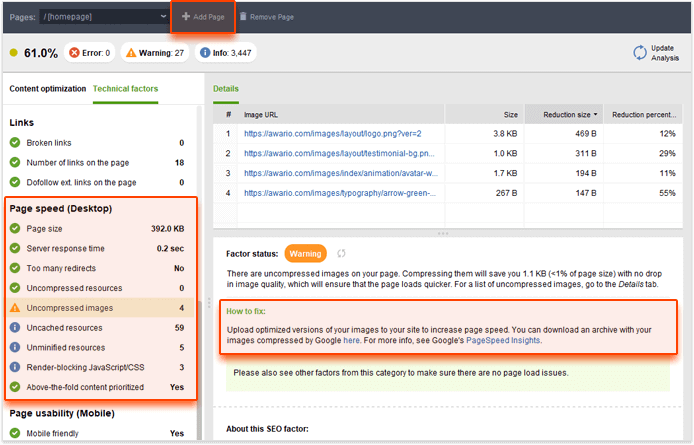
3. O brave new keyword research.
There is a curious phenomenon with typed and voice search. When you type, you use a number of separate keywords that succinctly reflect what you would like to find out. However, when you speak to your phone or any other device, you kind of treat it as a living creature, thus forming your queries as naturally sounding questions or statements. In fact, Google reports that 70 percent of the queries that Google Assistant receives consist of natural language.
As you have guessed, the approach to keyword research for these types of searches should be totally different. Voice search is more about long-tail conversational keywords and questions that people are likely to ask.
Long-tail keywords are less competitive and convert faster. So, if you target such keywords and phrases and answer questions that your potential customers are likely to ask, you stand a much better chance of ranking for these queries and appearing in search results.
How-to
1. Build your content around questions.
The question words — who, what, where, why, when, and how — are strongly associated with voice search queries, as they are conversational in nature. How do you get those question ideas? Rank Tracker's Common Questions research method would be a great help.
In your project go to Keyword Research, click the Suggest Keywords button, and choose the Common Questions research method. Enter your keywords and click Next. When your research is done, your dashboard will populate with ideas for your possible questions.
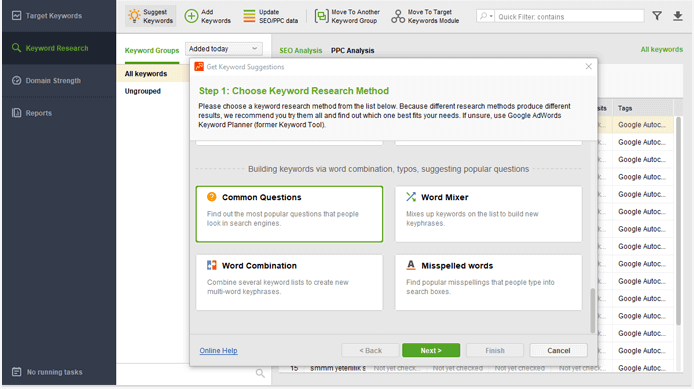
2. Check the People also ask box.
The "People also ask" box is just an infinity of related questions. Once you click on one of the queries, you receive a few more. After some clicking-through, questions may repeat, but on the whole, it is a magic box for new topics.
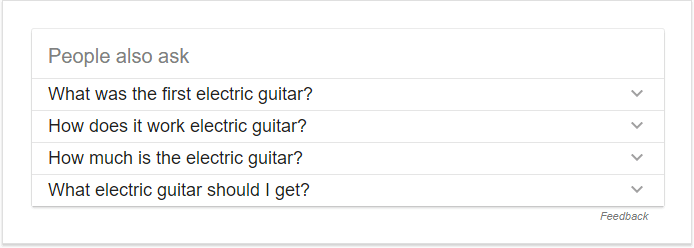
3. Create a Q&A page.
In case it is applicable, creating a Q&A page is an easy way to optimize your site for who, what, when, where, and why questions and those long-tail and conversational keyword phrases. This section will both ask and answer those questions that are relevant to your content and your customers' queries. Plus, whatever the overall tone of your content, you can be quite conversational in this section. The use of the phrases that people actually speak will probably resonate more with searchers.
4. Number zero.
The so-called "position zero" is an above-all-the-results chunk of the SERP space that contains a featured snippet — a box with an answer that supposedly gives the best quick information in response to the user's query. Unlike Google's Knowledge Graph, the box contains a link to the source. And the same source can be found on the page once again on its rightful position. And it does not mean that the first link in the SERP is usually featured. The link can come from positions 4 to as deep as 71! So we have to admit, position zero is a great way for better visibility and its consequential perks.
With the rise of mobile and voice search, featured snippets gained real value. Why? Let's see how a featured snippet looks on a smartphone:

It basically occupies the whole screen space! And after that, try to do a voice search for the same thing. It will read to you, guess what, this very featured snippet. Imagine you do not have the possibility to look at the screen at this moment. Then this answer will be your first and only. Scary and exciting at the same time.
Or take the example of Google Home. When it answers the searcher's question with the info from the Web, it will cite the source of this info by saying the site's name, and it will often send a link to the searcher's Google Home app.
Thus, what we really should do right now is to talk about how to get featured snippets.
How-to
1. Check engagement metrics.
Your website should look good in the eyes of Google, so that it could consider your content for a featured snippet. Use Google Analytics to check the pages that can be snippable, in your opinion. First of all, look at the pages with the higher page authority, i.e. those that have more quality backlinks pointing at them. If you see that their engagement factors (like bounce rate, CTR, session duration, new visitors, number of visited pages, etc.) are lower than average, it means that these pages need some polishing.
2. Make your content snippable.
You have to make Google see what a great supply of answers you have. Try to use the inverted pyramid formula to structure the data:
- start with the most important information to answer the question (follow the tips for long-tail keyword research from Section 3 of this post, and also make sure to check this guide on how to do keyword research);
- transit to more details beyond the direct answer and add visual support;
- wrap up with examples or case studies.
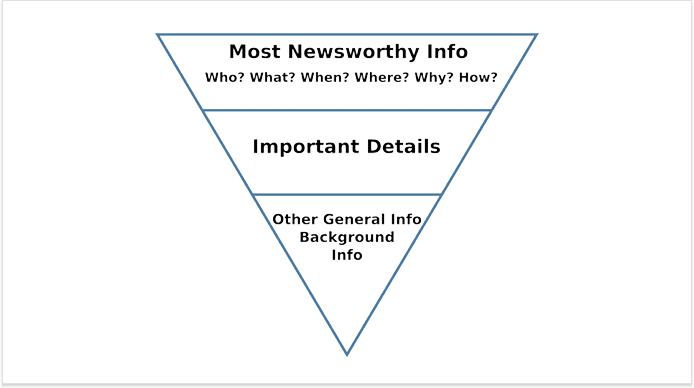
3. Optimize the format.
By wise HTML formatting and structuring your data, you can guide Google to the necessary spots to retrieve the data for the answer box. Try to format your target page according to the major types of featured snippets:
Paragraphs: Think of a short summary to answer a potential query, about 40-50 words to fit in the answer box. Format this paragraph in a paragraph HTML tag <p> and put this paragraph right under the heading for the question.

Tables: Google loves to include tables into featured snippets, as they are much easier to understand for computers, unlike natural language paragraphs. So when it makes sense, add the tabular data or reformat suitable paragraphs into tables. Mark up the table on your page using a <table> tag.
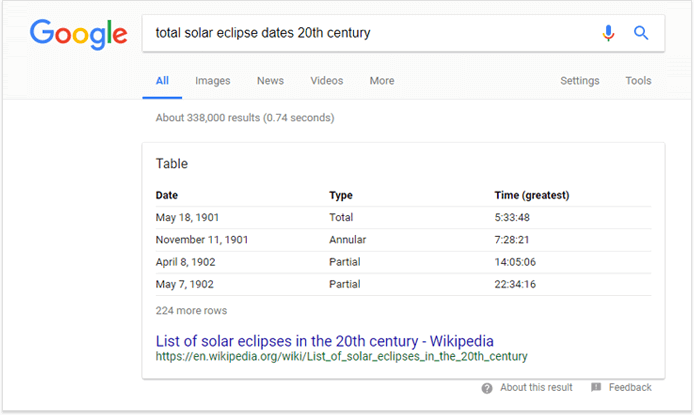
Lists: Give your list a title (H1 or H2) that matches the targeted keyword and format your "steps" as subheadings. Remember that Google can also make its own lists out of the text. So you can format your text with subheadings where it is logical to do so. Then Google will snip your subheadings and list them chronologically.

4. Request re-indexing.
Once you have done some changes to your pages that are ready to be snipped, use Google Search Console to re-crawl your pages. Apparently, this request almost instantly updates Google's index of the page. It means that your page can gain a featured snippet the same day you did re-indexing.
5. Local unchained.
If you run a local business, this section is for you, as voice searches are often more location-focused than any typed searches. I have mentioned earlier that voice searches usually come from mobile devices, and as most of these devices come with GPS, it allows users to perform searches that do not work the same in desktop search. It is especially relevant with the "Near me" searches.
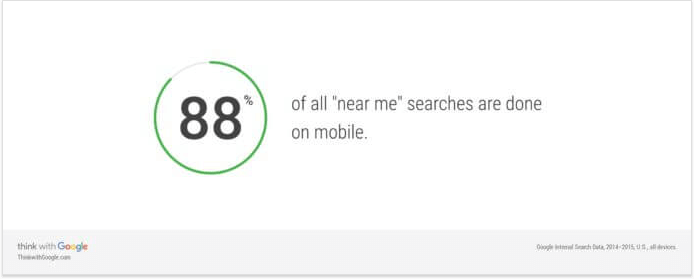
So, when a person makes an urgent query for some place or service, make sure to be there, as according to Google, three out of every four people who search for something nearby using their smartphone end up visiting a store within a day, and 28 percent of those searches result in a purchase.
How-to
1. Set up a Google My Business page.
A Google My Business account is a must if you need to gain a local pack listing (and have the directions to your shop read aloud to the searcher). Make sure to provide correct and relevant information: an address, map, contact details, and working hours (never forget to update this info in case of any changes). Put up a unique description for your business, choose the right categories, and upload at least five photos.
Plus, pick a quality preferred photo. This photo can't be a logo and should represent your business. Opt for a square picture, 250x250 pixels or larger.
2. Get positive reviews.
Try to get at least 5 reviews on Google, as it is critical for ranking in Google's local pack. If you see a happy customer, try to encourage them to leave a review. Here you can check out Google's guidelines for reviews. Remember that it will do you good if you reply to the negative comments and suggest some solutions. You can monitor your brand mentions via any monitoring tool, like Awario, for example.
3. Use Schema markup.
The use of microdata can give your site a local ranking boost for non-branded keywords. The local section of Schema.org has a variety of categories you can use, including an address, phone, and working hours. Make use of this masterly guide on implementing Schema markup.
4. Optimize AdWords campaigns for the "Near me" searches.
If you have already been running an AdWords campaign for your local business, you can maximize your visibility both for voice and regular search using the following tips:
- Use AdWords location extensions:
When you enable location extensions in AdWords, it will allow you to have your business' address, phone number, and directions to your location displayed alongside your ads. It is important if you want to show up in the "Near me" searches. - Use Google Maps Local Search ads:
This kind of ads appears above the organic results in Google Maps. You can use this guide to find out how to use this type of ads.
And one more piece of advice.
It is difficult to optimize for voice assistants and grasp their possibilities if you do not use them. Thus, buy some of these home devices, download the apps, play with them yourself, watch how your family and friends interact with them. It will let you get a feel how voice works here and there.

It is highly probable that 2018 holds an even greater shift towards mobile, voice search, and AI than we saw in 2017. No surprise that there are some musings over a possibility to separate voice queries in Google Search Console as their optimization needs slightly different tactics than those for traditional SEO. Indeed, how are we supposed to optimize without clear analytics?! No drama attached, of course it is possible, as it is possible to optimize for mobile not knowing which queries come from smart devices. However, when you understand the nuances for each type of search, you will do a marvelous job for your site's visibility.

By: Valerie Niechai




